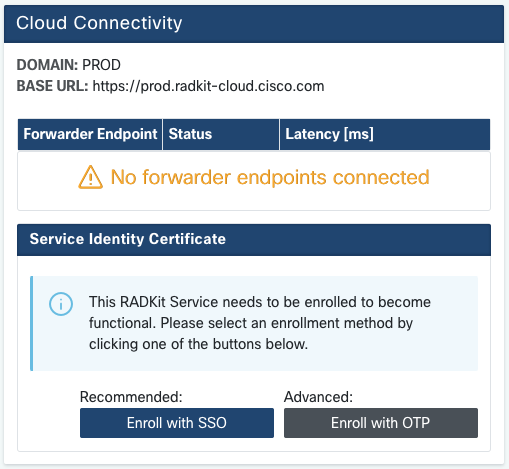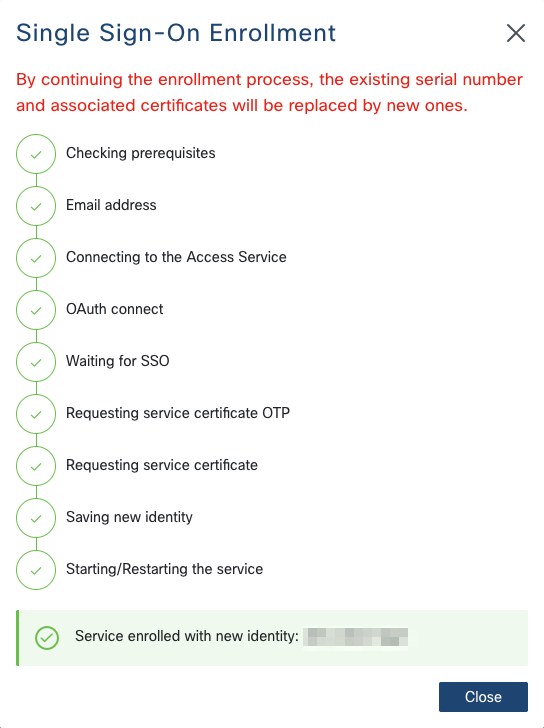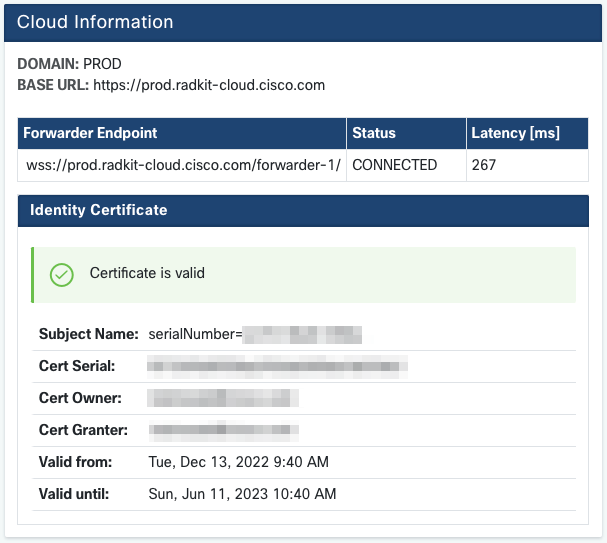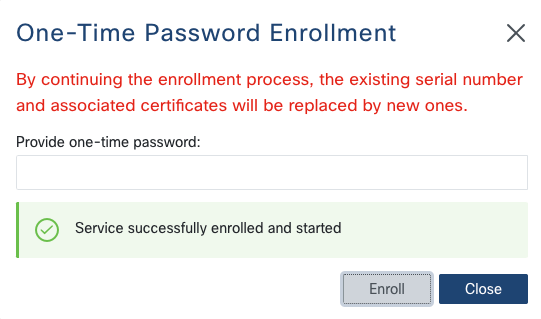Service enrollment
“Enrolling” means acquiring a RADKit Cloud identity and certificate for your RADKit Service. Without this step, RADKit Service can only receive connections locally (“direct connect”).
This page describes various ways that you can enroll your RADKit Service. If this looks overwhelming, check out the Quick start guide for a simple setup procedure.
Note
THIS PAGE IS A WORK IN PROGRESS
This page is being updated. The content below is from a previous release and may not be 100% accurate. Thank you for bearing with us while we update the documentation.
Using the WebUI
After logging in as superadmin, you are taken to the “Connectivity” screen:

Now you need to enroll the service. You have two options for that: by logging in to Cisco SSO, or by providing a one-time password generated through an authenticated RADKit Client.
Single Sign-On (SSO) enrollment
If you have a valid Cisco.com account, you can use SSO to enroll the Service by clicking the “Service Enrollment -> Single Sign-On” and following the wizard:

Note
In order for SSO enrollment to work, you need the following network connectivity:
the host running RADKit Service must have access to the RADKit Cloud;
the host running the web browser must have access to the RADKit Cloud and Cisco SSO.
After successfully completing the enrollment procedure you will see that the “Cloud Information” section is populated with details about the Service’s new identity certificate, as issued by the RADKit CA:

You can now finish setting up the Service by adding devices and remote users. You can also connect to the Service WebUI from a different host and manage it remotely if needed.
One-Time Password (OTP) enrollment
Note
This method is only for specific/advanced deployment scenarios, and for the vast majority of use cases, you should use SSO enrollment instead (see above).
First you need a one-time password (OTP) generated by a RADKit user who has access to an
authenticated RADKit Client. You can generate this OTP yourself, if needed, using the
client.grant_service_otp()
method in the Client (see API reference for details).
Click “Service Enrollment -> One-Time Password” and enter the OTP as it is given to you, then wait for the enrollment to finish (this may take a few seconds to complete):

You can now finish setting up the Service by adding devices and remote users. You can also connect to the Service WebUI from a different host and manage it remotely if needed.
Using the command line
After creating the superadmin account, you need to enroll the service. When enrolling through
the CLI, you need a one-time password (OTP) generated by a RADKit user who has access to an
authenticated RADKit Client. You can generate this OTP yourself, if needed, using the
client.grant_service_otp()
method in the Client (see API reference for details).
ServiceEnrollInfo(email='myuserid@cisco.com', serial='xxxx-yyyy-zzzz', otp='1111-2222-3333', domain_name='PROD')
----------- ------------------
email myuserid@cisco.com
serial xxxx-yyyy-zzzz
otp 1111-2222-3333
domain_name PROD
----------- ------------------
To enroll a Service using this OTP:
radkit-service enroll PROD:1111-2222-3333
OR enter PROD:1111-2222-3333 in the WebUI under Connectivity > Service Enrollment > One-Time Password
Run the command radkit-service enroll as instructed (or use the one shown above as a template),
provide the superadmin password when asked, and wait for the enrollment to finish (this may
take a few seconds to complete):
% radkit-service enroll PROD:1111-2222-3333
Superadmin password: ******** [correct]
Enrollment successful.
Now run the following command to start the service:
radkit-service --domain PROD run
After enrolling, start the Service (in this example we can omit PROD as it is the
default domain):
% radkit-service run

Finally, head to https://localhost:8081 (or the URL mentioned in the frame displayed in the
terminal) with your web browser, log in as superadmin, and finish setting up the Service
by adding devices and remote users. You can also connect to the Service WebUI from a different
host.